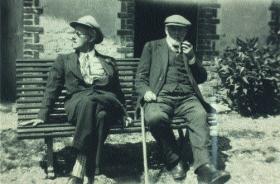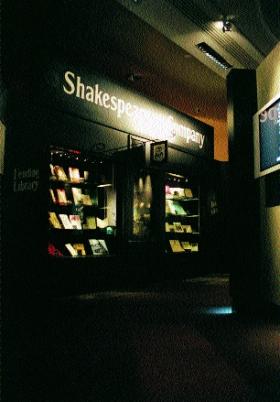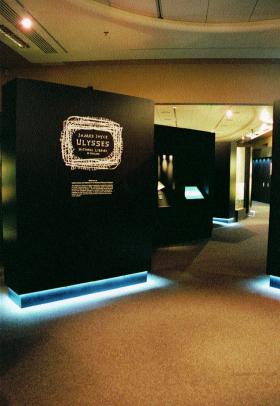Museum Eye
Published in Issue 3 (Autumn 2004), Reviews, Volume 12James Joyce and Ulysses
National Library of Ireland, Kildare Street, Dublin,
until summer 2005
by Tony Canavan

James Joyce with Clovis Monnier, father of Adrienne Monnier, who published the French translation of Ulysses. (National Library of Ireland)
By any standards this is a remarkable exhibition and probably represents the most minute analysis, discussion and display in one place of any book ever published. It sets a high standard for future events in the National Library’s new exhibition space. This itself is an impressive and welcome addition to the library. It consists of a bookshop and café alongside the new exhibition space, all laid out in brand-new rooms that contrast with the Victorian architecture of the original building. The bookshop and café are worth a visit in their own right but add an extra dimension to a visit to the Joyce exhibition as they provide an opportunity for extra reading on Joyce and his classic novel and a chance to rest your feet.
The exhibition originated in the acquisition by the library in 2002 of previously unknown drafts of Ulysses, mostly in copybooks, which form the heart of the display; but it is much more than that as it also presents a plethora of artefacts associated with Joyce and the Dublin of his day, ranging from hats, walking-sticks and spectacles to books, posters and letters. These in themselves would provide an impressive insight into the author and his times, including as they do, for example, the very first copy of the novel ever printed and a recreation of Joyce’s living quarters, but the whole thing is taken to a higher level by the audio-visual material.
There are the conventional photographs and films (running on flat-screen televisions) covering many aspects of Joyce’s life, how the work was received at the time, and the views of writers and critics then and now. However, the most interesting features are the interactive video display units (VDUs), which enable the visitor not just to learn about the characters and incidents in the novel in sound and vision but to virtually ‘handle’ the book, turn it in three dimensions and peruse it paragraph by paragraph—with the aid of a virtual magnifying lens, if required—all the while accompanied by a print and aural commentary. This is not just a fascinating journey into Ulysses but is also great fun! A further section of the exhibition consists of music-hall posters and music sheets as well as further interactive VDUs that allow you to select and actually hear the many songs featured in the book, such as ‘The Lost Chord’ and ‘The Bloom on the Rye’. This is a poignant reminder that Ulysses was written with an internal ‘soundtrack’ and of the importance of music in Joyce’s life. He performed in the annual Fleadh Cheoil and it was said that he could have had a career as a singer.
 The main objects of fascination, however, have got to be the notebooks themselves. Here we can actually see the original work in Joyce’s own hand and follow his thought processes as the novel developed, again with the aid of the best interactive equipment. The books are precious in themselves as relics of Joyce’s work, but because he annotated them and crossed out sections as they were transferred to the final draft in different coloured crayons they take on the appearance of works of art—perhaps Cubist art, as the book was condemned as ‘Cubist literature’ in America. This is appropriate as only illuminated medieval manuscripts have been displayed in this hi-tech interactive way before. A visitor could spend hours deciphering these books, examining each page in detail, with and without the crayon marks, on the VDUs and marvelling at Joyce’s mind at work.
The main objects of fascination, however, have got to be the notebooks themselves. Here we can actually see the original work in Joyce’s own hand and follow his thought processes as the novel developed, again with the aid of the best interactive equipment. The books are precious in themselves as relics of Joyce’s work, but because he annotated them and crossed out sections as they were transferred to the final draft in different coloured crayons they take on the appearance of works of art—perhaps Cubist art, as the book was condemned as ‘Cubist literature’ in America. This is appropriate as only illuminated medieval manuscripts have been displayed in this hi-tech interactive way before. A visitor could spend hours deciphering these books, examining each page in detail, with and without the crayon marks, on the VDUs and marvelling at Joyce’s mind at work.

The new exhibition space and bookshop at the National Library, Kildare Street, Dublin—an impressive and welcome addition to the library. (National Library of Ireland)
Getting round the exhibition is something of a Bloomsian odyssey itself. The visitor is met at the door by an attendant who explains in serious tones that everything is protected by the strictest copyright and that that means that nothing may be copied, photographed or recorded in any form, including taking notes (I was threatened with confiscation of my notebook). You are handed a leaflet that includes a map to guide you through the various displays that snake and twist through the gallery and soon, like Bloom, you are off on a meandering journey that sometimes seems to have no logic but is always enchanting. Although the exhibition is lettered and self-guiding, you are encouraged to find your own way about, to linger on what interests you or hurry past what you find off-putting, rather like reading Ulysses itself. Like Bloom, be prepared for some strange encounters and obstacles along the way, as the amazing popularity of the exhibition leads to log-jams at various points or people impolitely hogging VDUs that you want to use. The good point about the crowds is that you meet people from all over the world, including some genuine Dubliners, and hear all sorts of views expressed. There are plenty of attendants on hand to help explain the exhibits or guide you on your way. Given that Joyce spoke a number of languages, that Ulysses was written in three countries and has an international significance, it was unfortunate that these attendants were monoglot. I found it distressing to hear Irish people employ the British method of speaking English slowly and loudly to foreigners in the expectation of being understood.
You do not have to have read Ulysses or even be interested in James Joyce to enjoy this exhibition. In fact, if you go through it in detail, you will feel that you have read not only the novel but also the major critics on it and will be able to bluff your way in any conversation! The presentation and the technology are superb and will not be bettered anywhere in the world, but the spectacle is not used as a substitute for content. The exhibition is a thoughtful and thought-provoking panorama of James Joyce the artist and man, as well as a multi-dimensional examination and exposition of the most important piece of literature ever to have come out of Ireland. For native Dubliner and visitor alike it is a must-see.
Enquiries: www.nli.ie/joyce, int+353 (0)1 4294029
Tony Canavan is a former Museum Officer of Newry and Mourne District Council.
















